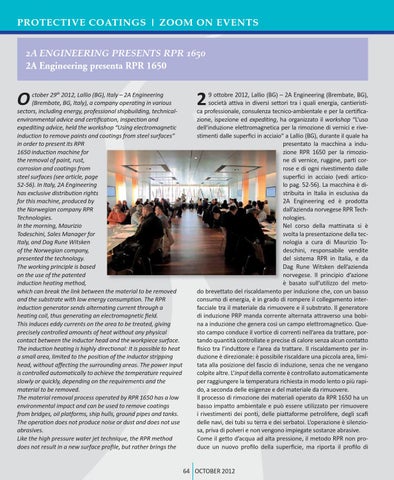PROTECTIVE COATINGS
ZOOM ON EVENTS
2A ENGINEERING PRESENTS RPR 1650 2A Engineering presenta RPR 1650
O
ctober 29th 2012, Lallio (BG), Italy – 2A Engineering (Brembate, BG, Italy), a company operating in various sectors, including energy, professional shipbuilding, technicalenvironmental advice and certification, inspection and expediting advice, held the workshop “Using electromagnetic induction to remove paints and coatings from steel surfaces” in order to present its RPR 1650 induction machine for the removal of paint, rust, corrosion and coatings from steel surfaces (see article, page 52-56). In Italy, 2A Engineering has exclusive distribution rights for this machine, produced by the Norwegian company RPR Technologies. In the morning, Maurizio Todeschini, Sales Manager for Italy, and Dag Rune Witsken of the Norwegian company, presented the technology. The working principle is based on the use of the patented induction heating method, which can break the link between the material to be removed and the substrate with low energy consumption. The RPR induction generator sends alternating current through a heating coil, thus generating an electromagnetic field. This induces eddy currents on the area to be treated, giving precisely controlled amounts of heat without any physical contact between the inductor head and the workpiece surface. The induction heating is highly directional: It is possible to heat a small area, limited to the position of the inductor stripping head, without affecting the surrounding areas. The power input is controlled automatically to achieve the temperature required slowly or quickly, depending on the requirements and the material to be removed. The material removal process operated by RPR 1650 has a low environmental impact and can be used to remove coatings from bridges, oil platforms, ship hulls, ground pipes and tanks. The operation does not produce noise or dust and does not use abrasives. Like the high pressure water jet technique, the RPR method does not result in a new surface profile, but rather brings the
2
9 ottobre 2012, Lallio (BG) – 2A Engineering (Brembate, BG), società attiva in diversi settori tra i quali energia, cantieristica professionale, consulenza tecnico-ambientale e per la certificazione, ispezione ed expediting, ha organizzato il workshop “L’uso dell’induzione elettromagnetica per la rimozione di vernici e rivestimenti dalle superfici in acciaio” a Lallio (BG), durante il quale ha presentato la macchina a induzione RPR 1650 per la rimozione di vernice, ruggine, parti corrose e di ogni rivestimento dalle superfici in acciaio (vedi articolo pag. 52-56). La macchina è distribuita in Italia in esclusiva da 2A Engineering ed è prodotta dall’azienda norvegese RPR Technologies. Nel corso della mattinata si è svolta la presentazione della tecnologia a cura di Maurizio Todeschini, responsabile vendite del sistema RPR in Italia, e da Dag Rune Witsken dell’azienda norvegese. Il principio d’azione è basato sull’utilizzo del metodo brevettato del riscaldamento per induzione che, con un basso consumo di energia, è in grado di rompere il collegamento interfacciale tra il materiale da rimuovere e il substrato. Il generatore di induzione PRP manda corrente alternata attraverso una bobina a induzione che genera così un campo elettromagnetico. Questo campo conduce il vortice di correnti nell’area da trattare, portando quantità controllate e precise di calore senza alcun contatto fisico tra l’induttore e l’area da trattare. Il riscaldamento per induzione è direzionale: è possibile riscaldare una piccola area, limitata alla posizione del fascio di induzione, senza che ne vengano colpite altre. L’input della corrente è controllato automaticamente per raggiungere la temperatura richiesta in modo lento o più rapido, a seconda delle esigenze e del materiale da rimuovere. Il processo di rimozione dei materiali operato da RPR 1650 ha un basso impatto ambientale e può essere utilizzato per rimuovere i rivestimenti dei ponti, delle piattaforme petrolifere, degli scafi delle navi, dei tubi su terra e dei serbatoi. L’operazione è silenziosa, priva di polveri e non vengono impiegate sostanze abrasive. Come il getto d’acqua ad alta pressione, il metodo RPR non produce un nuovo profilo della superficie, ma riporta il profilo di
64 OCTOBER 2012
